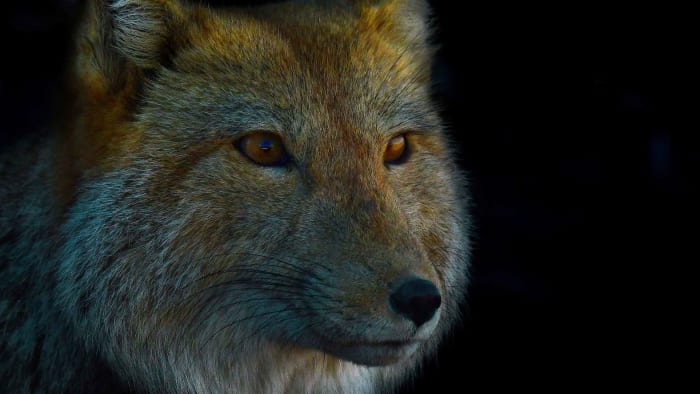 Listen to this article
•
15:34 min
Listen to this article
•
15:34 min
Rarely seen and rather understudied, the Tibetan sand fox is perhaps one of the most unique of all Indian foxes. This animal managed to stay out of sight and the limelight and was first reported in India as recently as 2005. Since around 2012, however, social media users around the world have discovered the Tibetan sand fox’s unique dead-pan face and squinting expression and used its image in a number of memes that have gone viral.
Of about 410 mammal species in India, seven are wild canids that can be spotted in different parts of the subcontinent. Located amidst this canid classification are three “true” fox species: the Indian fox (Vulpes benghalensis), Tibetan sand fox (Vulpes ferrilata), and red fox (Vulpes vulpes). Except for the red fox, which has three subspecies, no subspecies has been recorded for the other two. The Tibetan sand fox has a distinctive look, sporting a broad, squarish face and a relatively shorter muzzle than most known fox species. It’s also quite small, with a total body length of about 96-108 cm and weighing between 3-6 kilograms.
The Tibetan sand fox inhabits altitudes between 3,500 m to 5,200 m. The distribution of its favourite prey species, pikas, affects its geographical range. It is found in the high Tibetan Plateau (China), the Ladakh plateau, Sikkim, Nepal, and Bhutan. In India, it is found only in the high-elevation cold deserts of the Trans-Himalayas. Owing to the fact that it lives in a remote, mountainous habitat, we have very little concrete information on this fox.
Its population is estimated to be around 40,000 individuals. The IUCN Red List status of this animal is “Least Concern”, and the species is not listed on the CITES Appendices of threatened species either.

Much of the Tibetan sand fox’s habitat consists of almost treeless landscapes, including alpine meadows and steppes, desert steppes, and semi-arid and arid grasslands. Across their home ranges, these foxes have dedicated dens which are usually made at the base of boulders or low slopes for resting and raising their young. When threatened, foxes retreat to the safety of their dens and wait out the danger. Photo: Sourav Mondal
Cover photo: Kallol Mukherjee



While sand foxes prefer hunting alone, spotting a hunting pair is common. Their diet primarily consists of pikas, followed by rodents, marmots, hares, lizards, carcasses of bigger mammals, and, very rarely, livestock.
One of the most-researched aspects of the Tibetan sand fox’s behaviour is its relationship with pikas. Since pikas are diurnal and crepuscular (active at dawn and dusk), foxes can be seen hunting and stalking them in broad daylight. These foxes are experts at catching pikas and rarely inhabit areas without pikas or pika colonies. This could also explain why these foxes prefer living in open grasslands, as it is the primary habitat of pikas. Photos: Kallol Mukherjee (1,2), Sourav Mondal (3)

Another intriguing behaviour observed in the sand fox’s hunting techniques is the way it follows and forms a commensal relationship with brown bears. A commensal bond is an association between two organisms in which one receives benefits, and the other derives neither benefits nor harm. At times, these foxes follow brown bears that are hunting pikas. They try to get a pika when the bear digs the pika’s burrow from one end, and the pika tries to escape from another end.
These foxes help maintain the local rodent population by feeding on them and could also contribute to aerating the soil when they excavate pika burrows. Thus, they also provide important ecological services. Photo: Sourav Mondal

Living on the roof of the world, the sand fox does not face any immediate natural threats. Its chief predator is humans. Foxes are commonly snared, trapped and killed for their fur, which is usually turned into hats. Another problem of the fox’s habitat being close to established human settlements is the existence of free-ranging stray dogs. These dogs may compete with the fox for prey. Dogs also have the potential to pass on rabies and other canid diseases to foxes, and foxes, in turn, can transmit tapeworm diseases to dogs, which in turn can infect humans.
Across the border, the Chinese government has sponsored programmes involving poisoning pikas, the fox’s primary prey. This mass killing on the Tibetan plateau has allegedly been ordered to “protect” the plateau. However, if pika numbers fall, the fox population is also affected. Additionally, it can result in the secondary poisoning of Tibetan foxes. Photo: Sourav Mondal













